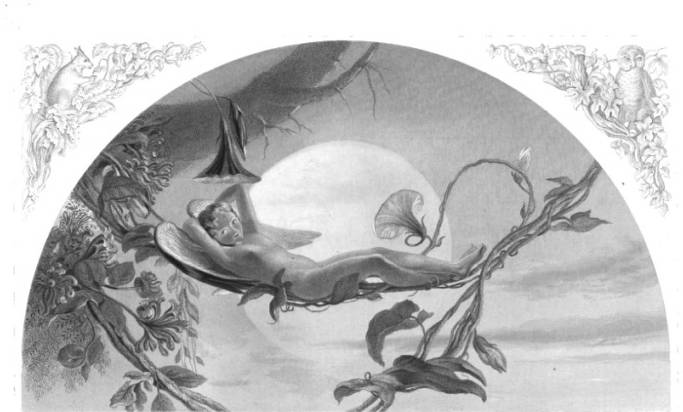
Ariel. H.J. Townsend, Painter. C. W. Sharp, Engraver. Exhibited at the 1845 Royal Academy accompanied by lines from Byron's Childe Harold (see below). 26 1/4 by 15 3/4 inches. Source: 1855 Art-Journal.
Commentary from The Art-Journal
Ariel, the most imaginative of all the fanciful creations of Shakspeare, seems to be a character almost beyond the criticisms of commentators on the writings of our greatest dramatist; a supernatural agent which baffles all logical and metaphysical inquiry, and is not to be measured by any standard of things on earth, or of spirits of the air. He comes before us in the play without note, warning, or introduction of any kind, fulfils his mission, gains his freedom, and departs without bidding us farewell. Few who have undertaken to discuss the characters of Shakspeare's plays historically, have thrown much light on Ariel. Mr. C. Knight, in his edition of the Works of the poet, introduces the following remarks from the writings of a German critic, Franz Horn, whose national sympathies may be presumed to have some fellowship with such mystic beings. "Opposed to Caliban," he says, "stands Ariel, by no means an etherial, featureless angel, but a real, airy, and frolicsome spirit, agreeable and open, but aiso capricious, roguish, and with his other qualities somewhat mischievous. He is thankful to Prospero for freeing him from the most confined of all confined situations, but his gratitude is yet a natural virtue (we might also add not an airy virtue); therefore he must (like man) be sometimes reminded of his debt, and held in check. Only the promise of bis freedom in two days restores him again to his amiability, and he then finds pleasure in executing the plans of his master with delightful activity."
Mr. Halliwell, in his valuable folio edition of Shakspeare, now in course of publication, has well observed that the character of Ariel is to a great extent the dramatist's own invention, and that his prototype was of a far less refined nature. He elsewhere adds, "The name of Ariel is presumed to be derived from the Hebrews, in which it is the appellation of one of the seven princes of angels or spirits who preside over waters under Michael; but Shakspeare, unless he "adopted the name from an older romance, might have readily and naturally formed it from the adjective arid." "Aerial spirits or devils," observes Burton, in his "Anatomy of Melancholy," "are such as keep guard most in the aire, cause many tempests, thunder and lightnings," &c.
There are doubtless many persons who regard Ariel as a female spirit, adopting the idea from the character being always represented on the stage by a female. This is done, however, because so spiritual a part better becomes one of the gentler sex, and for a more urgent reason, because the music to which the exquisitely beautiful songs in the play are set, is not suited to the male voice. It is a portion of one of these songs—" Where the bee sucks," &c, that gave to Mr. Townsend the subject of his picture. The passage he has sought to illustrate is:—
"Merrily, merrily, shall I live now,
Under the blossom that hangs on the bough."
But a line from another, and a modern poet, was appended to the title of the picture, in the catalogue of the Royal Academy, where it was exhibited in 1845, the commencing line of the stanza in Byron's "Childe Harold," where he so beautifully describes the effects of sunset on the mountains of Friuli. The painter has thus invoked the aid of two great poets in his composition: his "Ariel" is an exceedingly graceful impersonation, swinging listlessly ou the twined stalks—ono ought scarcely to call them branches of the honeysuckle and the convolvulus, realising thus the verse of Shakspeare. Byron's line is indicated by the full moon, and by the crimson edges of the clouds reflected from the setting sun. We may remark, however, that this is a very supernatural phenomenon, as the red clouds would be opposite the moon, and not beneath her, by all the laws of astronomical science. The picture is in the collection at Osborne.
Bibliography
“The Royal Pictures: Ariel.” Art-Journal (1855): 192-93. Hathi Trust version of a copy in the University of Michigan Library. Web. 23 March 2014
Last modified 23 March 2014